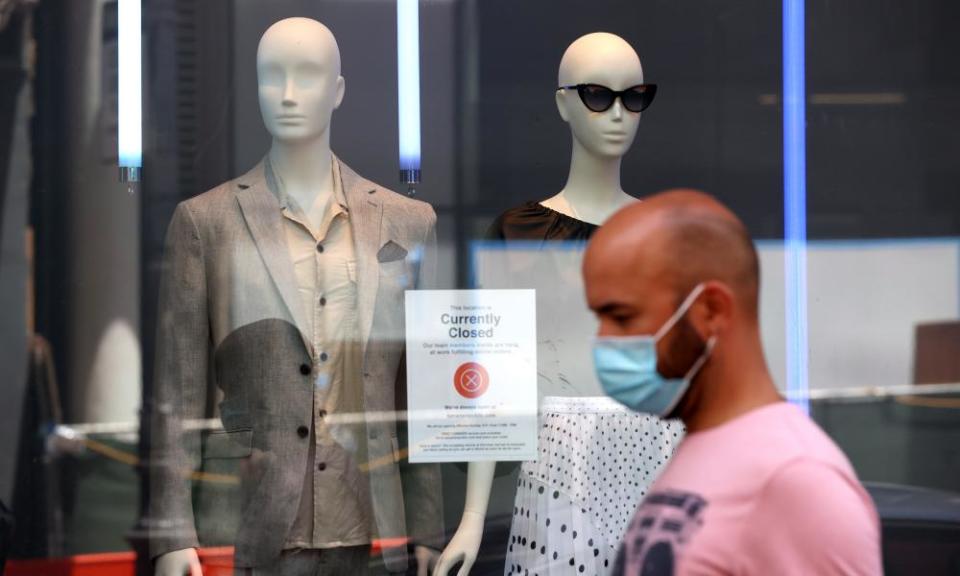US employers take back 4.8 million workers as coronavirus threatens economic recovery

US employers took back another 4.8 million workers last month as the coronavirus pandemic’s economic impact appeared to wane, marking the second consecutive month of jobs growth. But the latest figures are from before new surges in infections that threaten the fragile recovery.
The US Department of Labor announced on Thursday that the unemployment rate dropped to 11.1% in June from an initial estimate of 13.3% in May. The figure is still more than three times higher than the 3.5% unemployment rate in February before the US outbreak.
In a separate report the labor department said another 1.4 million Americans filed for unemployment benefits last week. In the last two weeks alone another 3 million Americans have filed for unemployment benefits.
The monthly figures are a snapshot of the second week of June when states across the US were reopening after weeks of lockdowns aimed at containing the spread of Covid 19. Leisure and hospitality gained 2.1m jobs in June, about two-fifths of all the gains, with employment in food services and drinking places up by 1.5m jobs.
Since the figures were compiled many states including California, Texas, Florida and New York have moved to slow or reverse re-openings as coronavirus cases have surged.
The latest jobs numbers come as Congress appears gridlocked over a new round of economic stimulus to help those who have been laid off. Although unemployment fell in May and June, 12m jobs have now been lost since February.
“I have never seen anything like this,” said Seth Harris, acting secretary of labor under Barack Obama. Harris said that as the search for a cure continued, it was vital that the states and the federal government worked to find a way to safely reopen the economy and agreed to inject more stimulus money.
Much of the US’s stimulus package has now been spent and a scheme that gave $600 a week extra in unemployment insurance runs out at the end of July. “That $600 is $12bn a week in spending for the US economy,” said Harris. “Seventy per cent of the US economy is consumption. If consumers don’t have money, the economy suffers.”
Without that $600, Michael Hessel-Mial, an adjunct professor and freelancer who lives in Kansas City, Missouri, said his state’s insurance would give him $350 a week – just enough to cover rent and basic expenses.
“I would go back to not being able to afford my utilities and insurance,” Hessel-Mial said, all while his chances of finding new employment have slimmed as colleges and universities have laid off staff members and instituted hiring freezes.
While Hessel-Mial has not received his unemployment insurance yet, his application was recently approved by the state, a month after he applied for insurance. With the instability of working on contract with his employers, many of whom have cut their adjunct and freelance budgets, knowing that he can get money to pay his bills has brought momentary relief.
“Just the very idea that I would be able to get unemployment that could help me finally pay my bills and not be trapped in debt, while I prepare for the next job, just the idea of having that is an emotional weight that I couldn’t really imagine,” Hessel-Mial said. “It feels like this is what we should have had all along.”
The patchwork approach to the reopening of the US has failed.
States including Georgia and Florida that reopened before the virus was under control are now experiencing surges in infection rates and new quarantine controls are closing businesses, triggering fresh job losses. Even when those states did reopen, their economies did not bounce back, said Harris. Fear meant people stayed at home.
An investigation conducted by Harris and the research company Remesh found only one in three American employees believe it’s safe to return to work.
“The American people are deeply fearful of the coronavirus and they are right to be fearful,” said Harris.
The pandemic has proved a unique challenge for the bureau of labor statistics (BLS). A record number of people are now classified as not being at work for “other reasons” – a category that is not included in the headline unemployment rate.
About 5.4 million workers with a job but not at work were included in the “other reasons” category in May. That’s 4.9 million more people in the “other” category than the average for the month of May between 2016 and 2019.
If all those “others” were included in the unemployment statistics, May’s unemployment rate would have been 16.4%, not 13.3%. As the BLS pointed out in a blogpost, not all those “others” are unemployed. The classification discrepancy “declined considerably” in June, according to the BLS, making the actual unemployment rate only about 1 percentage point higher than the reported level.

 Yahoo Finance
Yahoo Finance 